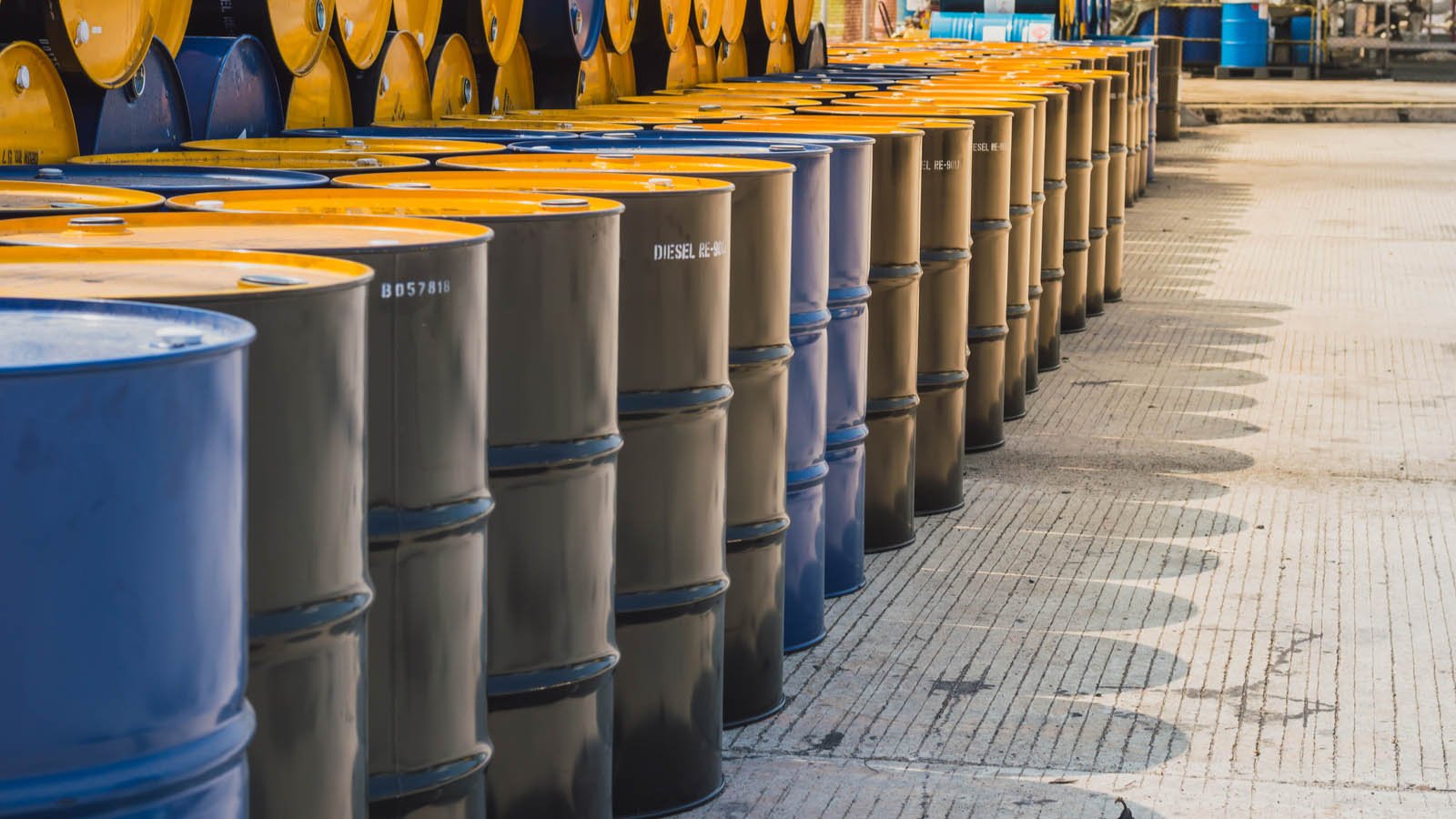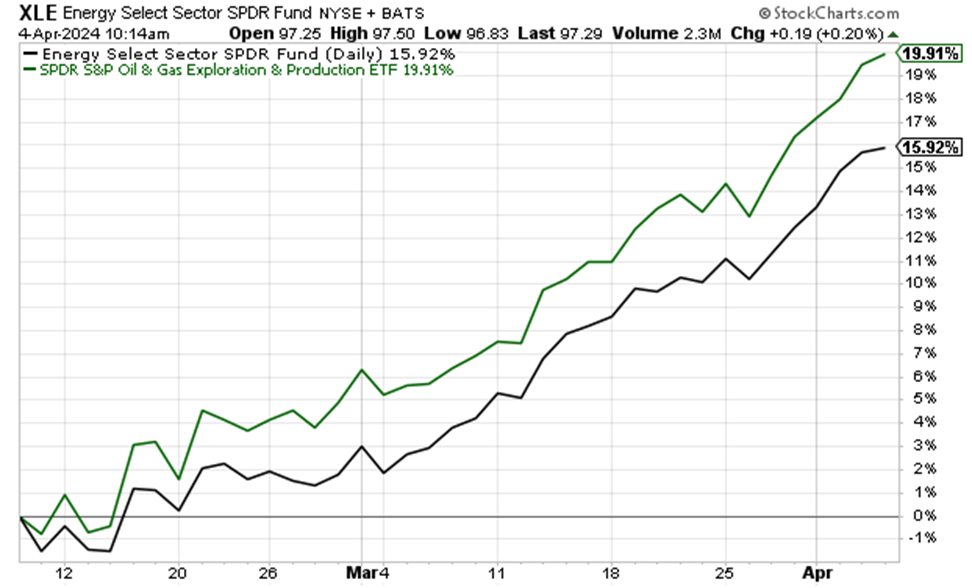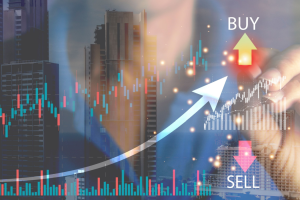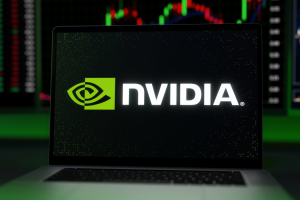
Our oil trades cruise higher … why Louis Navellier is calling for more gains … food inflation is hurting Europe … why it could be an issue in the U.S. … will the presidential election influence the Fed?
Our oil trade keeps working for us.
In our February 9th Digest, we wrote “oil and gas stocks are setting up for another run that’s going to make investors a hefty chunk of change.”
We then put two ETFs on your radar as the simplest way to play it: XLE, which is the SPDR Energy Select Sector ETF, and XOP, which is the SPDR Oil & Gas Exploration & Production ETF.
Since then, the price of West Texas Intermediate Crude has jumped 12%. This has served as a solid tailwind for our trades.
As you can see below, XLE and XOP are up 16% and 20%, respectively.

Legendary investor Louis Navellier expects more bullishness to come.
In his Flash Alert podcast in Accelerated Profits earlier this week, Louis highlighted curtailed Russian diesel exports due to Ukrainian attacks, and the Israeli assassination of two senior members of Iran’s Islamic Revolutionary Guard.
Here was his takeaway:
[These conflicts are] going to keep energy prices very high. So, we can profit from it, or we can worry about it.
I think energy is going to be a great bet through September…so, I think we should profit from it.
The macro variables pushing oil higher
In Louis’ latest issue of Accelerated Profits, he profiled why oil is behaving so bullishly today.
As we’ve been discussing, the first reason is geopolitical conflict. Due in large part to Ukrainian attacks, Russia’s diesel exports have dropped to 569,000 barrels per day. That’s a 21% decline from its average daily exports of 724,000 barrels per day in March.
From Louis:
Any further disruption to crude oil production due to these conflicts could easily push crude oil prices back to $100 per barrel.
Meanwhile, OPEC pumped only 26.42 million barrels of oil per day in March. That was 50,000 barrels per day less than in February.
Keep in mind, OPEC+ has extended its production cuts. Here’s Louis with those details:
[The cuts] will extend through the second quarter and take about 2.2 million barrels of oil per day out of the market.
Saudi Arabia continues to lead these production cuts, aiming to curtail production by one million barrels per day through the end of June.
And for one final reason to be bullish on energy, just look at its valuation.
Below is a heat map of the S&P 500. It’s showing us the price-to-earnings (P/E) ratios of all the companies in the S&P. More expensive P/E ratios show up as deeper shades of red while less expensive P/E ratio show as brighter shades of green.
While the image below represents P/E ratios from February, the overall S&P 500 has only gotten more expensive since then.
As you can see, the energy sector is a tiny island of green within a vast ocean of red.
(We’ll discuss the other tiny island of green – banking – in another Digest.)

Bottom line: It won’t be a straight, smooth climb, but the energy trade still has juice in it. Invest accordingly.
Meanwhile, keep your eye on this potential inflation tripwire
In Louis’ podcast, he touched upon a fascinating issue that, for now, isn’t affecting the U.S., but we want to keep it on our radar…
Policy-related food inflation.
From Louis, speaking about what’s happening in Europe:
You have inflation surging now because of high food costs.
A lot of that has to do with the green policy – seizing farmland, forcing farmers to kill their livestock, and of course, banning chemical fertilizer.
There’s a reason there are farm protests all over Europe.
This isn’t a major issue here in the U.S. yet, but political winds are shifting. Given the direction certain policies appear to be headed, similar food inflation could be on our doorstep soon.
From The Carolina Journal yesterday:
On January 29th, Steve Troxler, North Carolina’s Agriculture Commissioner, joined eleven other Republican Agriculture commissioners who signed a letter to six of America’s top banks, voicing their concerns with the Net-Zero Banking Alliance (NZBA), a project of the Paris Climate Accords.
NZBA banks would have to require that their customers measure and disclose greenhouse gas (GHG) emissions in certain sectors, agriculture being one of those sectors. Critics worry it could ultimately drive up costs of food, fuel, and fertilizer, and put the food supply at risk…
The implementation of these commitments would cause extreme consequences for farmers, including cutting beef and livestock consumption by half, using electric farm equipment, which is inefficient, and moving away from nitrogen fertilizer.
According to a report from the Buckeye Institute, the American farmer will see costs rise by a minimum of 34%. Grocery bills for a family of four will increase by $1,300 per year.
The Buckeye Institute created a model corn farm that followed the new carbon emission guidelines. It found that operational costs rose significantly, as did prices for nitrogen fertilizer, propane, and diesel fuel. As you’d expect, the tack-on effect for the average American consumer was higher food prices.
From the Buckeye Institute’s report:
The results are predictable and unsurprising, but many US policymakers seem unwilling to address or even acknowledge them.
That has to change, or the United States will face dire, economic consequences instead.
To be clear, we’re not making an argument for or against any specific policy. We’re simply tracking the potential impact on the American farm/family budget, and by extension, the economy and your portfolio. And as it looks today, that impact could be significant.
Now, if we follow these increasingly expensive breadcrumbs, what happens in November’s presidential election is likely to have a significant impact on how this issue plays out. And that dovetails into the Fed and its interest rate policy.
The Federal Reserve finds itself caught in between political crosscurrents as it considers interest rate cuts
The presidential election is on Tuesday, November 5th.
Between then and now, the Federal Reserve meets four times: May, June, July, and September (the November meeting falls the day after the presidential election).
Could the appearance of partisan politics impact the Fed’s interest rate policy?
Here’s The Hill:
Interest rates are becoming an increasingly partisan issue ahead of the 2024 election as Democrats exhort the Federal Reserve to slash rates and reduce borrowing costs while Republicans sound notes of caution about inflation sticking around…
Lawmakers are now increasingly falling into partisan camps in arguing for or against rate cuts, with Democrats sensitive to the effects of higher rates on housing costs and Republicans wary of cutting rarely prematurely.
“My goal here is to convince you to cut more and sooner,” Rep. Brad Sherman (D-Calif.) told Fed Chair Jerome Powell during a hearing of the House Financial Services Committee on Wednesday…
Meanwhile, Republicans are bashing at Democrats for calling for rate cuts before inflation has reached the Fed’s target rate of 2 percent, even though the central bank expects to cut rates at some point this year.
“Some Democrats have even trained fire on you, Chair Powell, blaming interest rate hikes —which were necessitated by Democrat spending — for the high costs and brazenly calling on you to make cuts prematurely,” House Financial Services Committee Chairman Patrick McHenry (R-N.C.) said Wednesday.
The Fed is intended to be an independent body, not answerable to the federal government. And Chairman Jerome Powell has echoed this independence many times when answering questions in his various press conferences. But at some level, he’s certainly aware of the risk of partisan optics at play.
So, how will these political pressures impact the Fed’s plan for cutting rates?
Well, we’re not getting much in the way of clues from the various Fed presidents. Their comments remain all over the place.
Yesterday, Atlanta Fed President Raphael Bostic said that the Fed should wait until Q4 to cut rates. He sees only one rate cut coming this year.
Similarly, earlier this week, Mary Daly, chief of the San Francisco Federal Reserve said there “is really no urgency” to cut rates.
In the other camp, we have Cleveland Fed President Loretta Mester. On Tuesday, she said “I still think three [rate cuts] is reasonable, but it’s close call.”
Let’s go back to Louis for his take:
This is a huge political issue.
The Fed doesn’t want to be responsible for any economic problems, so they tend to cut [rates] going into elections. They want to stay out of the political fray.
Donald Trump is going to be blaming them… So, we’ll see what happens.
It’s going to be fascinating to watch.
For more of Louis’ thoughts on how today’s political climate will impact your portfolio – and what to do about it – mark your calendar for next Wednesday, April 10th
Louis and a special guest are holding a live event called “Election Shock Summit.”
They see Wall Street turbulence on the way due to the election – potentially, with a market-moving event happening on May 1. Louis and his guest will be revealing what they see coming, and the critical steps to take in your portfolio now in preparation.
We’ll bring you more details about the event in the days to come. But to go ahead and reserve your seat for this free event today, just click here.
We’ll keep you updated on all these stories here in the Digest .
Have a good evening,
Jeff Remsburg




